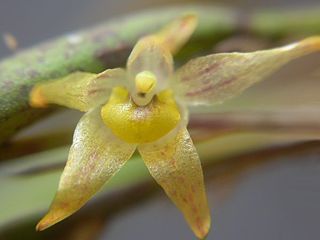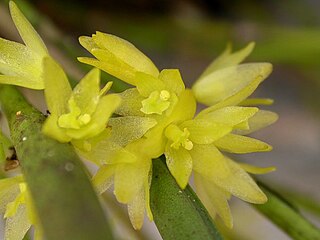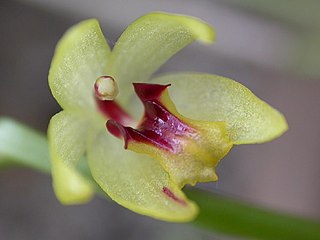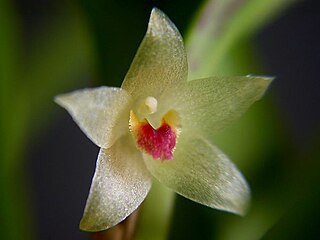
Octomeria is a plant genus belonging to the family Orchidaceae. The genus comprises about 150 species native to the Neotropics, mostly in Brazil.

The hybrid elm cultivar Ulmus × hollandica 'Superba' is one of a number of intermediate forms arising from the crossing of the Wych Elm U. glabra with a variety of Field Elm U. minor. Boulger tentatively (1881) and Green more confidently (1964) equated it with a hybrid elm cultivated in the UK by Masters at Canterbury in the early 19th century, known as "Masters' Canterbury Seedling" or simply the Canterbury Elm. Loudon examined a specimen sent by Masters and considered it a hybrid, calling it U. montana glabra major.

Octomeria aloefolia is a species of orchid endemic to eastern Brazil.

Octomeria chamaeleptotes is a species of orchid occurring from Brazil to Argentina (Misiones).

Octomeria crassifolia is a species of orchid found from eastern Ecuador, Brazil, Paraguay, Uruguay and northern Argentina.

Octomeria cucullata is a species of orchid endemic to Brazil.

Octomeria decumbens is a species of orchid endemic to southern and southeastern Brazil.

Octomeria grandiflora is a species of orchid endemic to Brazil.

Octomeria juncifolia is a species of orchid endemic to southern and southeastern Brazil.

Octomeria minor is a species of orchid endemic to the Guyanas.

Octomeria palmyrabellae is a species of orchid endemic to Brazil.

Octomeria pinicola is a species of orchid found from Brazil to Argentina (Misiones).

Octomeria rodeiensis is a species of orchid endemic to southeastern Brazil and Ecuador.

Octomeria rohrii is a species of orchid endemic to Brazil.

Octomeria tricolor is a species of orchid endemic to southeastern Brazil.
Octomeria nana is an orchid species in the genus Octomeria found in Venezuela.

Liptena praestans is a butterfly in the family Lycaenidae. It is found in Cameroon, the Republic of the Congo, the Democratic Republic of the Congo, Uganda, Tanzania, Zambia and possibly Sierra Leone and Ivory Coast.

Octomeria brevifolia is a species of orchid endemic to South America.

The hybrid elm cultivar Ulmus × hollandica 'Fastigiata' was first listed and described as Ulmus glabra fastigiata, a narrow-crowned elm with large smooth leaves, by Petzold and Kirchner in Arboretum Muscaviense (1864). C. Berndt of the Berndt Nursery, Zirlau, Schweidnitz, described an elm of the same name in Mitteilungen der Deutschen Dendrologischen Gesellschaft, that he had received in 1903 "from a renowned nursery in Holstein" as Ulmus montana fastigiata macrophylla. A tree of that name had been listed by Dieck in 1885 without description. Berndt reported that his U. glabra fastigiata was "easy to confuse with U. montana superba", a tree "known in the Magdeburg region as Ulmus praestans", a statement confirming that, like that cultivar, his tree was a form of U. × hollandica. Karl Gustav Hartwig who received specimens of U. praestans from Kiessling of the Magdeburg city nursery in 1908, concluded (1912) that U. glabra fastigiataKirchner was indistinguishable in leaf or habit from U. praestans. An U. campestris glabra fastigiataArb. Musc. [ = Kirchner] was distributed by the Hesse Nursery, Weener, Germany, in the 1930s, where it was listed separately from U. praestans.

The wych elm cultivar Ulmus glabraHuds. 'Superba', Blandford Elm, with unusually large leaves, was raised by Gill's of Blandford Forum, Dorset, in the early 1840s as Ulmus montana superba and was quickly distributed to other UK nurseries. It was confirmed as a form of wych, and first described, by Lindley in The Gardeners' Chronicle, 1845, later descriptions being added by Gill (1845) and Morren (1848), who called it U. montana var. superba. Morren had adopted the name 'Superba' from the Fulham nurseryman Osborne in 1844, who supplied him with the tree – presumably one of the nurseries supplied by Gill. Morren states that 'Superba', already in cultivation in England, was introduced to Belgium by Denis Henrard of Saint Walburge, Liège, that in 1848 it had been present in Belgium for only three years, and that this variety was the one described as 'Superba' by Osborne, whom Henrard had visited at his nursery in Fulham in September 1844. 'Blandford Elm', with leaves of the same dimensions, was soon for sale in the USA.



















